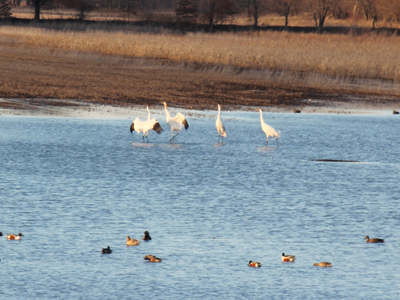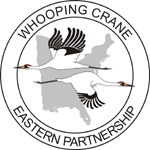| Media Contact: Joan Garland, Outreach Coordinator, 608-381-1262 Nesting News! Five Whooping Crane pairs are confirmed on nests as of April 16th! Following are the details on the pairs (“W” denotes a wild-hatched chick, followed by the year of hatch): 12-02/19-04 (parents of W1-12 and W3-10, a captive produced egg) 9-03/3-04 (parents of W1-10) 9-05/13-03 (parents of W8-12) 32/41-09 (Update 4/19: After further observations we believe that this pair is sitting on an empty nest platform and have not laid any eggs. This is the first time nesting for these two Direct Autumn Release birds, and we have had a number of young pairs do this in the past) 33-07/5-09
As of April 3, there were 84 Whooping Cranes confirmed in central Wisconsin. Most notably, both wild-hatched chicks from the 2012 season have returned with their parents to the locations where they hatched last spring. W1-12 is a young male Whooping Crane that hatched on April 30, 2012, and W8-12 is a female that hatched on May 21, 2012. Late last fall, both of these young cranes followed their respective parents to suitable winter habitat in southern Indiana (below, W1-12 and his parents, along with DAR 19-10, in Indiana). This spring, their arrival back at their northern breeding grounds marks the first full complete migration cycle for these Whooping Crane chicks produced in the wild.
Whooping Cranes were on the verge of extinction in the 1940s. Today, there are only about 600 birds in existence, approximately 445 of them in the wild. Aside from the 108 WCEP birds, the only other migrating population of Whooping Cranes nests at Wood Buffalo National Park in northern Alberta, Canada and winters at Aransas National Wildlife Refuge on the Texas Gulf Coast. A non-migrating flock of approximately 20 birds lives year-round in the central Florida Kissimmee region, and an additional 28 non-migratory cranes live in southern Louisiana. WCEP asks anyone who encounters a Whooping Crane in the wild to please give them the respect and distance they need. Do not approach birds on foot within 200 yards; remain in your vehicle; do not approach in a vehicle any closer than 100 yards. Also, please remain concealed and do not speak loudly enough that the birds can hear you. Finally, do not trespass on private property in an attempt to view or photograph Whooping Cranes. Whooping Crane Eastern Partnership founding members are the International Crane Foundation, Operation Migration, Inc., Wisconsin Department of Natural Resources, U.S. Fish and Wildlife Service, the U.S. Geological Survey’s Patuxent Wildlife Research Center and National Wildlife Health Center, the National Fish and Wildlife Foundation, the Natural Resources Foundation of Wisconsin, and the International Whooping Crane Recovery Team. Many other flyway states, provinces, private individuals and conservation groups have joined forces with and support WCEP by donating resources, funding and personnel. More than 60 percent of the project’s budget comes from private sources in the form of grants, public donations and corporate sponsors. |
Share this video with your friends and help us spread the word that disturbing, harassing or killing Whooping Cranes is a crime.
Make a gift to support Whooping Crane conservation.
|

 Thanks to the efforts of WCEP, there are now 108 Whooping Cranes in the wild in eastern North America, which was part of their historic range.
Thanks to the efforts of WCEP, there are now 108 Whooping Cranes in the wild in eastern North America, which was part of their historic range.

